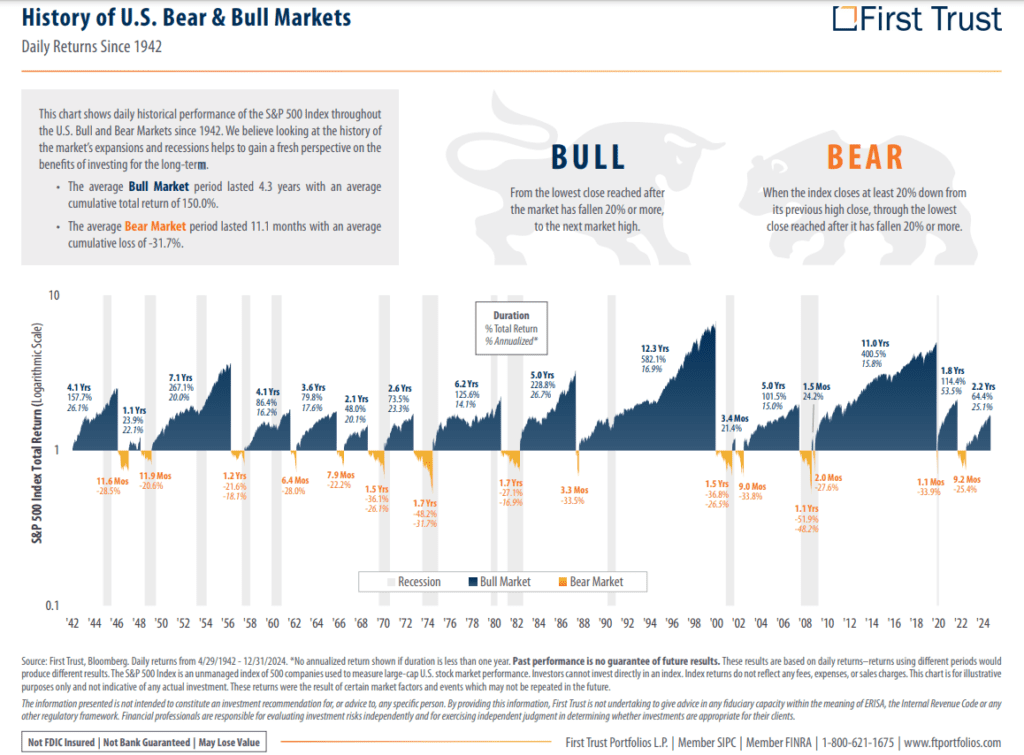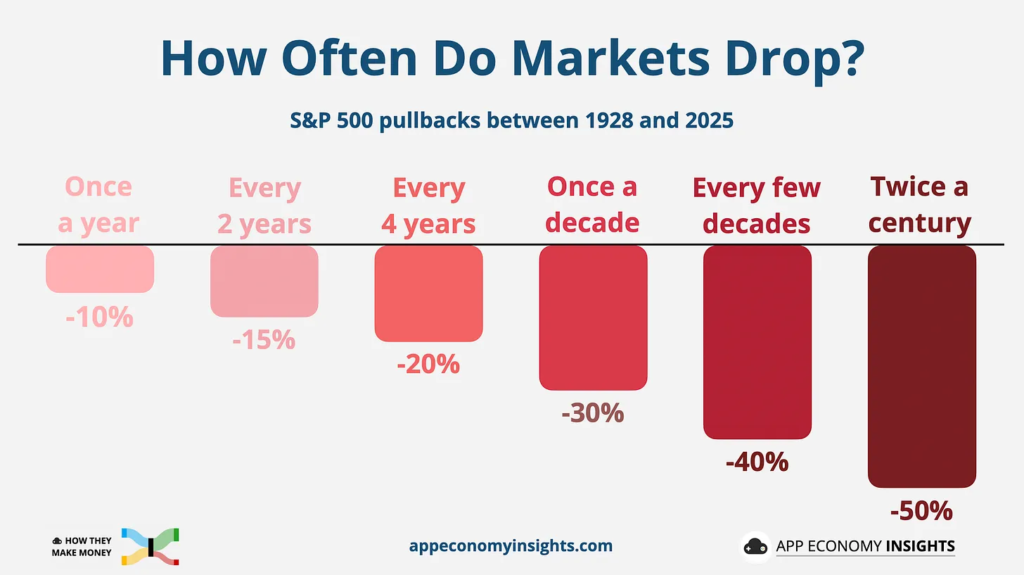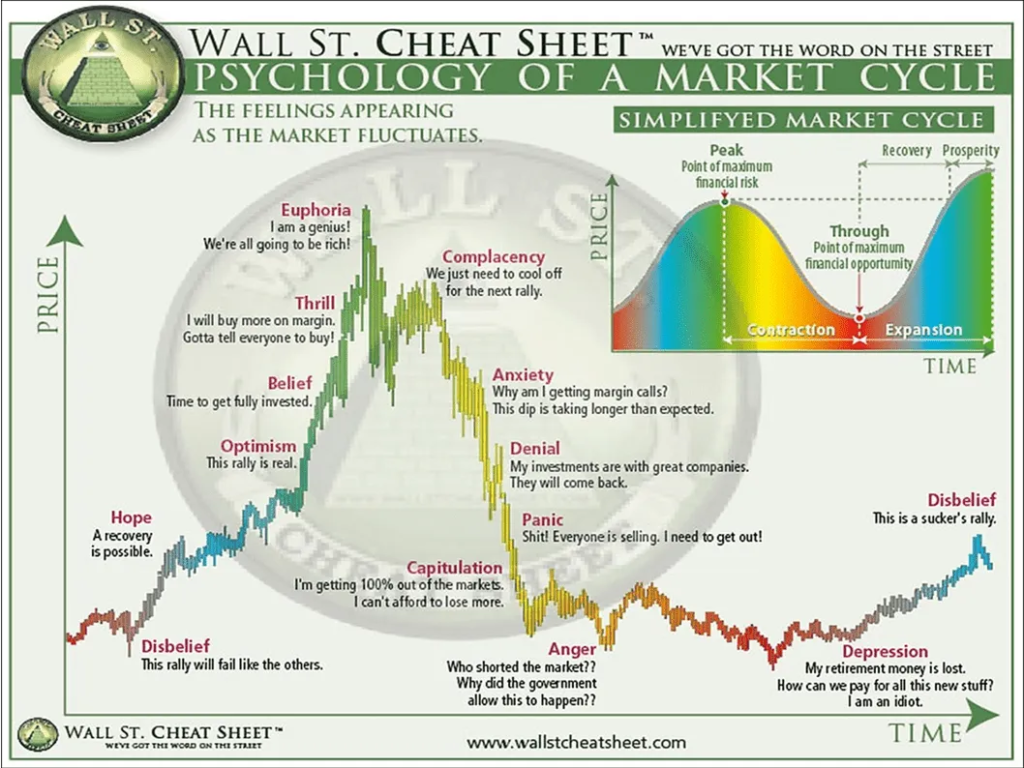A bear market is typically defined as a 20% drop or more from a recent peak in major indices like the S&P 500 or Nasdaq. But more than just numbers, it’s a psychological test for every investor.
Since 1945, the S&P 500 has gone through 15 bear markets:
- Average decline: -32%
- Average time to bottom: 11 months
- Average time to recover: 1.7 years


If current trends follow the average, we may bottom out within the next year and recover by late 2026.
“You make most of your money in a bear market — you just don’t realize it at the time.” – Shelby Cullom Davis
Bear markets are not anomalies — they’re built into the DNA of investing. The only real question is: how will you respond?
What History Tells Us
Bear markets feel endless when you’re in them. But history tells a different story:
- 12 of the last 15 bear markets saw full recoveries in under three years
- Only outliers like 1973-74, 2000, and 2008 took longer due to deep structural issues
Importantly, market rebounds often begin before the economy improves. If you wait for clarity, you may miss the strongest gains.


Peter Lynch: “Every recovery since WWII has been preceded by a market rally — and those rallies begin when conditions still look bleak.”
Why most investors underperform:
- Trying to time the bottom
- Waiting for headlines to turn positive
- Listening to “this time is different” narratives
Yes, every recession is different — but recovery always follows.
On average:
- Recessions last ~11 months
- Expansions last ~6 years
So why spend years preparing for downturns… when they’re short, often priced in, and inevitably followed by growth?
The Psychology of Downturns
The biggest threat in a bear market isn’t your portfolio — it’s your mindset. When prices drop:
- You feel like it’s only going to get worse
- Every small rebound feels like a trap
- Fear hijacks your long-term perspective
And here’s the catch:
Most portfolio damage doesn’t come from bad stocks — it comes from bad decisions made under stress.
Your job is not to forecast the bottom. It’s to avoid panic and stick to your process. Common emotional traps:
- Extrapolating losses (“20% down = 50% coming”)
- Freezing and hoarding cash
- Confusing volatility with permanent loss
In short, volatility is the price of admission for long-term returns.


How to Stay Invested (Even When It Hurts)
Discipline beats prediction. You don’t need to be brilliant — you need to be consistent. The secret weapon? A system. Here’s a simple 4-rule framework:
- Invest monthly — don’t try to time the market
- Avoid doubling down on losers
- Don’t panic-sell winners
- Invest with a 5+ year horizon
Why this works:
- Spreads risk
- Forces action when others freeze
- Removes emotion from the equation
- Gives compounding time to work
Want to go one level deeper? Start journaling your decisions:
- Why am I buying?
- What would break my thesis?
- How does this fit my long-term goals?
Writing down your reasoning builds clarity and helps fight emotional overreactions.
Adam Smith: “If you don’t know who you are, the market is an expensive place to find out.”
And before any major decision? Sleep on it. If it can’t wait 24 hours, it’s probably emotion-driven.
How to Find Opportunities
This is when the next generation of winners goes on sale. Bear markets are clearance racks for quality businesses. But only those who are prepared will recognize it. What to focus on:
- Companies with strong fundamentals
- Positive cash flow and low debt
- Durable competitive moats
- Ability to invest through downturns
Strategy: Use a rule-based approach for new positions — e.g., only invest when P/E < 20, or add in equal amounts over multiple months.
Revisit your watchlist: Those stocks that felt too expensive last year? They might be fairly priced or undervalued now.
Use regret-minimization: Would you regret not buying this stock if it doubles in 5 years?
Your Bear Market Checklist
Let’s wrap up with a simple, repeatable checklist to stay focused when the world looks shaky:
✅ Zoom Out
Bear markets are part of the cycle — and recoveries tend to last much longer than the downturns.
✅ Stay Calm
You don’t need perfect timing. You need to avoid panic and stick to the plan.
✅ Automate Your Strategy
Monthly contributions, pre-set buying rules, and journaling will help keep emotions in check.
✅ Focus on Resilience
Buy companies that can survive — and lead — in the next cycle.
✅ Buy Selectively
When prices fall, future returns rise. Use that to your advantage.
✅ Be Patient
Compounding doesn’t reward speed. It rewards time + consistency.
Charlie Munger: “If you’re not willing to react with equanimity to a 50% market decline… you’re not fit to be a common shareholder.”
Final Word
This isn’t just about surviving — it’s about positioning yourself to thrive. Bear markets don’t break great investors — they build them.
Volatility is uncomfortable. But so is missing the rebound. The next bull market always starts quietly, when few are looking.
Be the investor who’s ready.
Disclosure: This article does not represent investment advice. The content and materials featured on this page are for educational purposes only.
Related:
De-Dollarization: The Global Shift That Could Redefine the Future of Money
Dollar Role in Global Economy: Analyzing US dollar future’s reserve currency status
The Dot-com bubble burst: How irrational exuberance led to tech stock collapse
Energy Transition and Its Macro Impact
Collapse of Enron (2001) – How corporate fraud reshaped corporate governance










